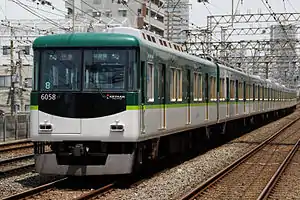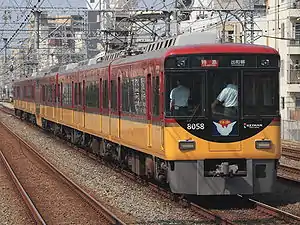Keihan 6000 series
The Keihan 6000 series (京阪6000系, Keihan 6000-kei) is an electric multiple unit (EMU) commuter train type operated by the private railway operator Keihan Electric Railway in Kyoto, Japan, since 1983.[1]
| Keihan 6000 series | |
|---|---|
 Keihan 6000 series train on a service to Yoyodabashi | |
| In service | 1983– |
| Manufacturer | Kawasaki Heavy Industries |
| Family name | City commuter |
| Constructed | 1983–1993 |
| Entered service | 1983 |
| Refurbished | 2013– |
| Number built | 115 vehicles |
| Number in service | 112 vehicles (14 sets) |
| Formation | 8 cars per trainset |
| Fleet numbers | 6001–6014 |
| Capacity |
|
| Operator(s) | Keihan Electric Railway |
| Line(s) served | Keihan Main Line |
| Specifications | |
| Car body construction | Aluminium |
| Train length | 149,600 mm (490 ft 10 in) |
| Car length | 18,700 mm (61 ft 4 in) |
| Width | 2,720 mm (8 ft 11 in) |
| Height | 4,185 mm (13 ft 8.8 in) |
| Doors | 3 pairs per side |
| Maximum speed | 110 km/h (70 mph) (operation) 120 km/h (75 mph) (design) |
| Traction system | TDK–8135A |
| Power output | 155 kW (208 hp) |
| Acceleration | 2.5 km/h/s |
| Electric system(s) | 1,500 V DC overhead wire |
| Current collection method | Scissors-type pantograph |
| Safety system(s) | Keihan ATS |
| Track gauge | 1,435 mm (4 ft 8 1⁄2 in) |
The series won the Laurel Prize from the Japan Railfan Club in 1984.[1]
Overview
The 6000 series was introduced in 1983 with 11 7-car sets built by the end of 1983. The remaining 38 cars would be built in 10 batches spreading from 1986 until 1993.[2]
The sixth batch, built in 1989, was a seven-car set with four cars being built as prototypes for next-generation VVVF traction motors. In 1993, three of those test vehicles would be renumbered and incorporated into an existing 7000 series set.[2] In lieu, three replacement cars would be built in December 1993 as the tenth and last batch of the series.
These trains would be the basis for the 7000 series introduced in 1992.[3]
Interior
Passenger accommodation consists of longitudinal bench seating throughout.
Formations
The seven-car trains are formed as follows, with two or three motored ("M") cars and four or five non-powered trailer ("T") cars.[4]
| Car | 1 | 2 | 3 | 4 | 5 | 6 | 7 | 8 |
|---|---|---|---|---|---|---|---|---|
| Designation | Mc | M | T | T | T | T | M | Mc |
| Numbering | 6000 | 6100 | 6600 | 6500 | 6750 | 6550 | 6150 | 6050 |
- "Mc" cars are motored driving cars (with driving cabs).
- "M" cars are motored intermediate cars.
- "T" cars are unpowered trailer cars.
- The "Mc 6000" and "M 6150" cars each have two scissors-type pantographs.
Gallery
 Inside car 6761
Inside car 6761 Driver controls of Keihan 6053
Driver controls of Keihan 6053 Keihan 6054 on a service to Yoyodabashi
Keihan 6054 on a service to Yoyodabashi Keihan 6001 in an older green livery
Keihan 6001 in an older green livery
References
- "6000系" [6000 Series]. Keihan.co.jp (in Japanese). Retrieved 2 February 2020.
- "京阪電気鉄道 現有車両プロフィール 2009" [Keihan Electric Railway Current Vehicle Profile 2009]. The Railway Pictoral (in Japanese). Denkisha Kenkyukai. 822: 284–285. 2009.
- 私鉄車両年鑑 2013: 大手15社営業用車両完全網羅 私鉄車両年鑑2013 [Japan Private Railways Annual 2013] (in Japanese). Tokyo, Japan: Ikaros Publications Ltd. 20 March 2013. p. 79. ISBN 978-4-86320-693-9.
- 私鉄車両編成表 2020 [Private Railway Vehicle Organization Table 2020] (in Japanese). Japan: Kotsu Shimbunsha. 2020. p. 143. ISBN 978-4-330-06020-0.
External links
| Wikimedia Commons has media related to Keihan 6000 series. |
- Official website (in Japanese)
